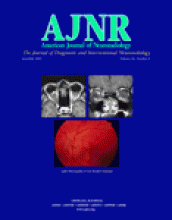Abstract
BACKGROUND AND PURPOSE: High tissue contrast and short acquisition time are desirable when scanning patients. The purpose of this report is to describe the implementation of a new technique for generating high gray matter (GM) and white matter (WM) contrast in a short scan time, make a quantitative evaluation of the contrast efficiency, and explore its potential applications in neuroimaging.
METHOD: A fully interleaved T1-weighted inversion recovery (T1IR) sequence with phase-sensitive reconstruction (PS-T1IR) is implemented. This sequence is compared with conventional T1-weighted spin-echo imaging (T1SE) and T1-weighted fluid-attenuated inversion recovery (T1FLAIR). The time efficiency and contrast enhancement have been quantitatively analyzed in normal volunteers. The performance of the sequence is evaluated in >30 patients with neurologic disorders. The sensitivity of PS-T1IR relative to T1SE in detecting gadolinium enhancements is also evaluated.
RESULTS: PS-T1IR is more time-efficient than T1SE and generates better GM-WM contrast. It results in the best contrast-to-noise ratio (CNR) efficiency (1.16) compared with T1FLAIR (0.73) and T1SE (0.23). For a typical clinical protocol, PS-T1IR takes only 1:30 minutes versus 2:40 minutes for T1SE imaging for the whole brain coverage. Although gadolinium enhancements are detected with comparable sensitivity on both PS-T1IR and T1SE sequences, in certain instances, the latter sequence appears to be more sensitive in demonstrating gadolinium enhancements within WM.
CONCLUSION: PS-T1IR has the highest CNR efficiency compared with T1FLAIR and T1SE. It is a very practical technique for neuroradiologic applications.
- Copyright © American Society of Neuroradiology












